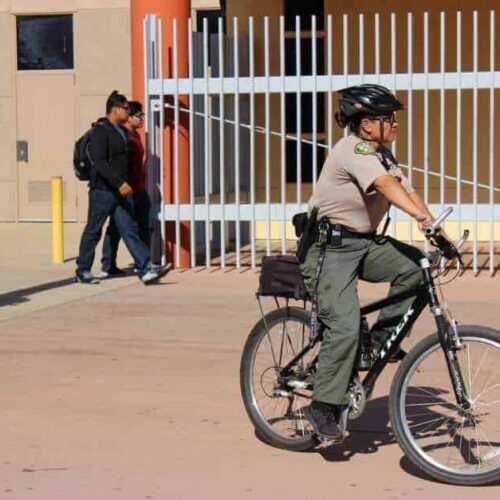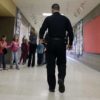Introduction
For more than a decade, civil-rights advocates have pushed to limit the use of police in schools. They’ve cited evidence of children damaged by racial profiling and to news reports such as the Center for Public Integrity’s “Criminalizing Kids” investigations. They’ve won changes in jurisdictions nationwide that have reined in the power of police on school grounds.
But after protests against George Floyd’s May 25 death in Minneapolis — when an officer pressed his knee into Floyd’s neck for nearly nine minutes — it took only days for some cities to decide to remove city police officers from schools altogether.
On June 2, the Minneapolis Public Schools board voted to cut ties to that city’s police department, which has provided school resource officers to the district at a cost of $1 million a year. In Oregon, Portland’s public school superintendent said June 5 that the district intends to end the regular presence of school resource officers and boost spending on school counseling.
Denver terminated a contract with the city’s police department that put school resource officers on campuses. During the 2018-2019 school year, 29 percent of students Denver schools referred to law enforcement were Black, although Black students account for 13 percent of all students.
Police interactions can result in tickets for alleged crimes, arrests or a record that officers in some districts keep on children at schools.
From New York City to New Haven, Connecticut, to Los Angeles and Oakland, California, school leaders and activists are pushing to cut ties to city police forces or redirect police budgets to spend more money on educational support and counseling services.
The protests against police brutality and racism after Floyd’s death have buoyed the movement to end school policing. But calls for removing police could fail to catch on in more conservative areas, or encounter resistance from residents who worry that without police in schools, students will be vulnerable to school shootings or other crimes.
Although it’s more common to employ school officers from city police departments, some large districts, such as Houston and Los Angeles, spend millions of dollars annually on their own police forces.
In those districts, officers also have been accused of heavy-handed policing targeting Black and Latino students. The Los Angeles Unified School District allocates $70 million a year to maintain its police department, which patrols streets and schools, and is unionized.
Starting in 2012, Public Integrity reported multiple stories about massive ticketing by school police of Los Angeles students, 40 percent of them 14 or younger. Some of the tickets were for disrupting the peace because of squabbles at school. Even 6- and 7-year-olds were ticketed.
Los Angeles school police also set up sting operations around schools, almost all in lower-income and Latino and Black neighborhoods, to ticket children arriving at school late. Tickets required students to miss school to make court appearances, a phenomenon that outraged Los Angeles juvenile court judges, who argued that almost all children sent to court were Latino or Black and that schools needed to provide students more family support.
Because of community activists and Public Integrity reports, the Los Angeles school police chief ordered officers to stop ticketing children 12 years old and younger. Discussions about other reforms have continued.
In 2015, Public Integrity reported on widespread ticketing of students in San Bernardino, California. Officers used heavy-handed policing against students, and probation officers were posted inside schools with primarily Latino and Black students.
Also in 2015, Public Integrity identified Virginia as the state with the highest rate nationwide of referring students to law enforcement. Police were issuing tickets and arresting Black students with disabilities at disproportionate rates.
Incidents of school resource officers charging children with crimes stirred controversy and led to modest local and state reforms. But the trend also sparked five years of state fights to approve broader reforms.
In one notorious case of policing, Public Integrity reported that an 11-year-old African American student in Lynchburg, Virginia, who is autistic, was charged with felony assault on a police officer because he struggled to break free when the officer grabbed him in a hallway. The school resource officer also charged the sixth-grade boy with disorderly conduct for kicking a trash can.
Public Integrity found that local police reports showed that more than 3,500 complaints police filed against students in Chesterfield, Virginia, during a three-year period were for “simple assault” or disorderly conduct.
More than half the students who received citations were Black, although they accounted for only 26 percent of the study body. The citations also showed that half the students cited were 14 or younger. They included 27 children younger than 10 who were accused of assault, and five children younger than 10 who were accused of making bomb threats.
In July, a number of long-fought school policing reforms will go into effect in Virginia, which the new Democratic-controlled legislature approved.
The Virginia Legal Aid Justice Center explains that reforms it urged legislators to adopt:
- prohibit charging Virginia students for disorderly conduct for behavior at school, on a school bus or at a school-sponsored event;
- require more transparency of data detailing school resource officers’ interactions with students;
- improve training for police officers and require more frequent review of agreements between police departments and schools;
- clarify that school administrators have the discretion, but not the obligation, to report students to police if they believe that a child’s behavior could be considered a misdemeanor crime or a status offense, such as truancy.
Read more in Education
Criminalizing Kids
What you need to know about school policing
Your child was stopped by a police officer at school. Now what?
Criminalizing Kids
When schools call police on kids
Schools refer tens of thousands of students to law enforcement every year. Black children and students with disabilities get the brunt of it.






Join the conversation
Show Comments